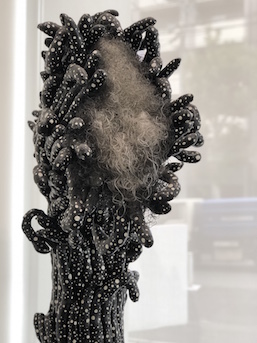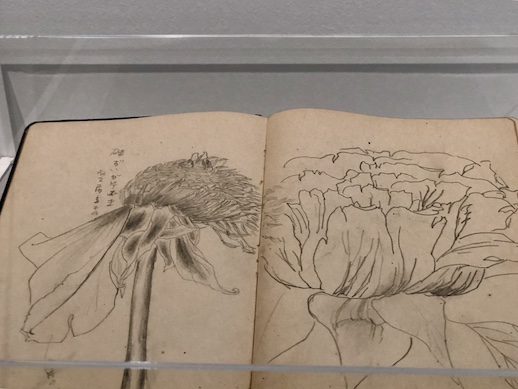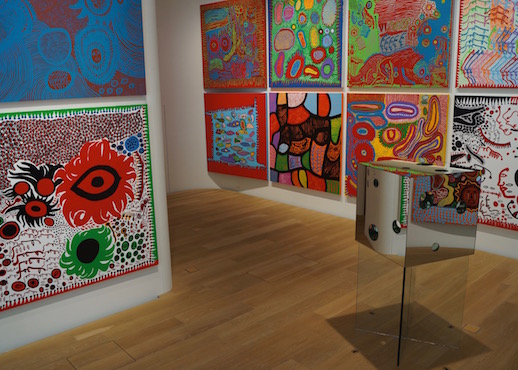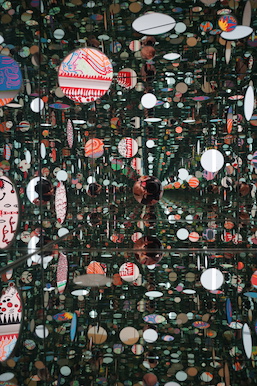I Want You to Look at My Prospects for the Future – Plants and I

With a show about plants, you could say that Kusama is returning to her roots – pun intended. She was born in 1929 in Matsumoto, Nagano Prefecture as the youngest daughter of a family that ran a nursery and seed farm. Being surrounded by plants from a young age is surely why flora is such an important motif for her. Some of the visual and aural hallucinations she has experienced since the age of ten have also included flowers. The press release from the museum states, “Plants have been mirroring a significant part of her identity – embodying both beloved subjects and frightening figures instilling fear through hallucinations.” Kusama’s botanical-themed works can be regarded as alternative self-portraits.
In the lobby, the polka-dotted soft sculpture Black Flower (1986) indicates that this show is not a repeat of her wildly successful 2017 solo exhibit at The National Art Center, Tokyo. Soft sculpture was popular with feminist artists in the ‘60s and ‘70s, and Kusama was at the forefront of the movement. Covering a plant with soft phalluses and hairy, vagina-like seedpods comes as a timely statement. With Kusama being one of the most Instagrammable artists these days, it is not a surprise that either she or the museum’s curator has selected a piece that resonates with the #MeToo movement. This choice also signifies that the show draws upon Kusama’s archives, demonstrating what a lengthy and rich career she has had.
The second floor fulfills this promise of looking back on Kusama’s history with a little bit of everything from her youth to the present. Alongside a childhood photo, viewers can see a sketchbook from her schooldays. Across from these are two video screens with Flower Obsession – Gerbera (1999) and Flower Obsession – Sunflower (2000) played on loop. The juxtaposition of these works shows how far Kusama has come in adopting both artistic and technological trends.

Botanical motifs have been used throughout Kusama’s life in a variety of media. The photo of her at the entrance shows her at the age of ten holding flowers. A poem printed on the wall is about violets, but also about her hallucinations, which have led to her philosophizing about “removing” herself, an act she refers to as “self-obliteration.” Work before her life-changing trip to the United States includes detailed pencil sketches of flowers, Nihonga paintings from her college days, and abstract paintings such as the Pollock-esque Accumulation of Falling Flowers (1955) and Self-portrait (1950), in which a red sun or sunflower dominates her face. The botanical themes continue in her collaged self-portraits from the ‘70s, the soft sculpture Mirror Shangri-La (1999), and her infamous polka-dotted pumpkins. Photos of the performance Self-Obliteration by Dots (1968) interestingly have little if any connection to the botanical theme, but they signify her work in that particular genre as self-portraits. Keep a look out for the three small pumpkins cleverly tucked into what would have otherwise been dead space near the stairs. These three are relatively new pieces from 2016. Also, they are surprisingly not made from moulds like her larger pumpkins, but are sewn from stuffed fabric and painted with acrylics. All of this variety illuminates how Kusama has developed as an artist up to the present.
The gallery on the third floor consists of recent work, including large acrylic paintings from the ongoing ‘My Eternal Soul’ series. Kusama uses mainly primary colors and moves back and forth between abstract and figurative painting. According to the press release, “this series can be considered the culmination of Kusama’s art, mixing styles and elements she has developed throughout her oeuvre.” Of course mirror rooms are her signature, and The Passing Winter (2005) is a version of those, kindly altered by the curators for people who might otherwise feel claustrophobic in the dark, enclosed spaces typical of those rooms. This large mirror box has several peepholes at various heights so several people can enjoy the kaleidoscopic experience at the same time without any line-ups or time limits. The paintings surround the box and their colors are reflected in the mirrors, making the box seem invisible or obliterated at certain angles.

Repeat visitors will already have seen the installations on the top two floors, but both they and first-timers can still enjoy them. Pumpkins Screaming About Love Beyond Infinity (2017) is one of Kusama’s smaller mirror rooms with polka-dotted pumpkins on only one side of the room. Regular visitors can still find new details that they might not have noticed before. For example, the reflection on the top of the case might seem obvious to the viewer, but look carefully at the intricate miniature reflections on the bottom of the case between the pumpkins. These reflections also change as the lighting changes. Starry Pumpkin (2015) near the library on the top floor has faded slightly, but that is to be expected since it is exposed to the elements. That’s right – it’s installed in open air. A recent typhoon even blew in a few leaves. Note that because it’s outdoors you might not be allowed into this area if the weather is bad. If the day is sunny, however, this must be one of the most relaxing spaces in Tokyo.

Yayoi Kusama Museum
Open: 11:00–17:30 on Thursday–Sunday and national holidays
All tickets must be purchased in advance online from the museum’s website.
Entry is timed and only valid for a specific 90-minute time slot.
Tickets go on sale at 10:00 a.m. (Japan time) on the first day of each month. Tickets must be purchased at least two months in advance and are not available at the door.
www.yayoikusamamuseum.jp (English and Japanese)
Michelle Zacharias
Michelle Zacharias



